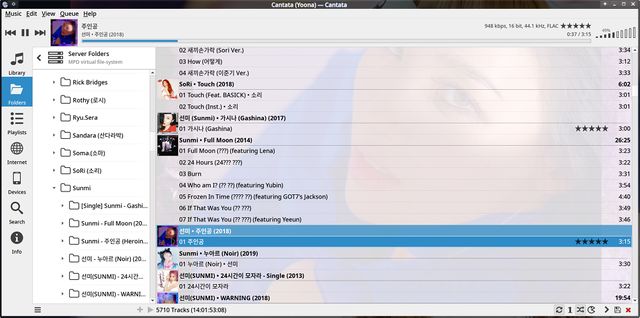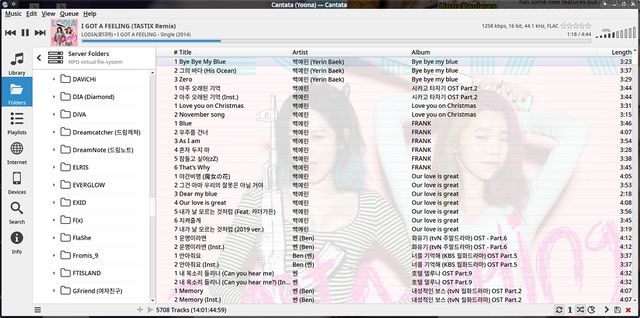Cantata
Cantata is a very nice, user-friendly and feature-rich front-end for the music player daemon media player. It supports dynamic smart playlists and dynamic playlists which can use metrics like a songs rating, age and length. It has a radio station browser with support for Dirble, IceCast, ShoutCast and TuneIn, a great search functionality, easy to use library, playlist and file folder browsing and support for controlling multiple music player daemon instances. It is built using Qt and KDE framework libraries. Cantata is the best and most feature-rich MPD client and the combination of Cantata and MPD is the overall best music player solution for Linux desktops.
Cantata is free software under the GNU GPL v3.
Cantata is not a stand-alone music player, it is meant to provide a nice graphical user-interface for a local or remote Music Player Daemon instance. You will need to setup and configure mpd to use it.
Features and usability[edit]

Cantata version 2.4.0 released February 15th, 2020 showing the playlist with the "Group by Albums" view.
Cantata relies on the Music Player Daemon for music library indexing and actual music playback. It is a front-end for MPD and is a really smooth one.
Cantata has a main playlist window on the right side where songs can be shown either grouped by album or be shown as a "tabbed" view. The playlist window can be configured to show the album of the currently playing song in the background. A fixed static image can also be used.

The Cantata playlist set to show a "tabbed" view.
Right-clicking on a song in the playlist brings up a number of useful options. You can rate songs, prioritize them, lookup the artist, album or track in your library, set a track to be played next, edit the tracks ID tag, remove duplicate or invalid songs and much more.
The left side of cantata has a handy toolbar which lets you quickly access your music library, local folders, playlists, Internet radio stations and podcasts and external devices. There is also very advanced search tool available in the toolbar. Cantata can make remote mpd instances play local files using a built-in http server.
The keyboard short-cut ctrl+f lets you search for files in your library while ctrl+⇧ Shift+f lets you search for files in the playlist. Both search features support search-as-you-type.
Cantata can play local music files from any folder in addition to those served by a Music Player Daemon.
Cantatas playlist management is perhaps the most useful and powerful of all music players available on Linux. You have your "Stored playlists," and there are also dynamic playlists and smart playlists. You can rate songs in your current playlist and use those ratings and other information such as genre, artist, or any other metadata to make smart playlists. You can, for example, make a list of all k-pop songs you have rated between 4 and 5 stars.
The playlist has a random mode, a consume mode and a repeat mode. There is a "priority" system which is very useful if you've set it to random play. You can right-click a few songs you'd like to play in the near-future and set them to the highest priority and those will be played in random order before Cantata moves on to randomly play the rest of your playlist.
Cantata lets you have multiple MPD instances configured and you can easily switch between one on your desktop and one on a Pi or something in the kitchen.
Verdict and conclusion[edit]
Overall Cantata is an excellent music player. It does everything a music player should and more. It is essentially perfect.
The only, perhaps deal-breaking, problem with it is that it is a front-end for the Music Player Daemon - it is not a stand-alone music player. If you are willing to spend 5 minutes configuring mpd then Cantata is the by far best music player there is. Elisa may be a better choice if you want a stand-alone database-oriented music player and you can't be bothered to run a local mpd instance.
Configuration[edit]
It's mostly fine out of the box. You do need to point it to your MPD daemon. That's about it.
You will also like want to go to Edit then Preferences and Interface then Play Queue and set Background Image to Current album cover. This, as the option indicates, gives you the album cover of the currently playing song (if available) as playlist background. Configuring this is not essential but it's something you likely want to do. That particular feature is broken in Cantata 2.4.0. It works in <=2.3.3 and it will be fixed in 2.4.1 that version is released.
Installation[edit]
Cantata is available in all the major distribution's repositories. Just install it as usual.
Links[edit]
Cantatas developer Craig Drummond has not setup any dedicated website for it. It has a GitHub page with source code and a readme.me file at github.com/CDrummond/cantata and a page listing stale release at github.com/CDrummond/cantata/releases.
Alternatives[edit]
Stand-alone music players:
| Program | rating | framework | music collection database |
|---|---|---|---|
| Audacious | Qt5 or GTK2 | ||
| DeaDBeeF | GTK | ||
| Elisa | Qt/KDE | ||
| Exaile | GTK | ||
| GNOME Music | GTK/GNOME | ||
| Strawberry | Qt | ||
| qmmp | Qt |
discontinued / abandoned / bankrupt & finished: Clementine | Amarok
Music Player Daemon clients:
mpd is a database-oriented music player daemon which can be controlled by numerous front-end programs.
| Program | rating | framework | type |
|---|---|---|---|
| Cantata | Qt | X11 | |
| GMPC | GTK | X11 | |
| mpc | Command-line | terminal | |
| ncmpc | ncurses | terminal | |
| xfmpc | GTK/Xfce | X11 |
discontinued / abandoned / bankrupt & finished: Sonata | KMP | Glurp

Enable comment auto-refresher
Tumeo
Anonymous (967521bb8e)
Permalink |